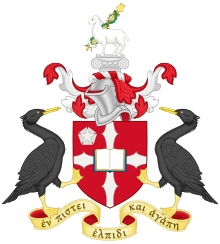 Coat of arms Liverpool Hope University | |
| Motto | Ancient Greek: ὲν πιστει ὲλπιδι και ἀγἀπη |
|---|---|
Motto in English | In faith, hope and love |
| Type | Public |
| Established | 1844 – Saint Katharine's College (as Warrington Training College) 1856 – Notre Dame College (as Our Lady's Training College) 1964 – Christ's College 1979 – Liverpool Institute of Higher Education 1995 – Liverpool Hope University College 2005 – Liverpool Hope University |
| Chancellor | Professor Monica Grady |
| Vice-Chancellor | Professor Claire Ozanne |
| Students | 5,520 (2022/23)[1] |
| Undergraduates | 4,450 (2022/23)[1] |
| Postgraduates | 1,070 (2022/23)[1] |
| 121[2] | |
| Location | , England |
| Campus | Hope Park, Childwall & Creative Campus, Everton |
| Colours | |
| Website | www |
Liverpool Hope University (abbreviated LHU) is a public university with campuses in Liverpool, England. The university grew out of three teacher training colleges: Saint Katharine's College (originally Warrington Training College), Notre Dame College, and Christ's College. Uniquely in European higher education, the university has an ecumenical tradition, with Saint Katharine's College having been Anglican and Notre Dame and Christ's College having both been Catholic. The Anglican Bishop of Liverpool David Sheppard and the Catholic Archbishop of Liverpool Derek Worlock (who give their names to the university's Sheppard-Worlock Library) played a prominent role in its formation.[3] Its name derives from Hope Street, the road which connects the city's Anglican and Catholic cathedrals, where graduation ceremonies are alternately held.[4]
The university is both a research and teaching intensive institution. It has gained notable recognition for its teaching.[5]
In 2023, it achieved an overall Silver rating in the UK Government's Teaching Excellence Framework (TEF),[6] and rankings in teaching-focused league tables is comparable with lower-performing Russell Group universities.[7][8]
Former Vice Chancellor Professor Gerald Pillay OBE summarised the university as a liberal arts college-style environment where "[students are] a name, not a number."[5] Its "small and beautiful" ethos has been contrasted with the larger neighbouring University of Liverpool and Liverpool John Moores University (LJMU).[5]
- ^ a b c "Where do HE students study?". Higher Education Statistics Agency. Retrieved 23 September 2024.
- ^ "Student Headcount". Liverpool Hope University.
- ^ Elford 2003, p. 7
- ^ Liverpool Hope University. "The Liverpool Hope story". Retrieved 1 September 2020.
- ^ a b c Hodges, Lucy (28 June 2007). "Liverpool Hope – Europe's only ecumenical university – is resisting the urge to expand". The Independent. Archived from the original on 3 July 2007. Retrieved 31 August 2020.
- ^ "Teaching Excellence Framework 2023 Outcomes". Office for Students. Retrieved 28 September 2023.
- ^ "University league tables 2019". The Guardian. 29 May 2018. Retrieved 3 September 2020.
- ^ "University league tables 2020". The Guardian. 7 June 2019. Retrieved 3 September 2020.